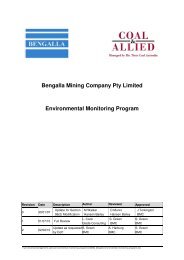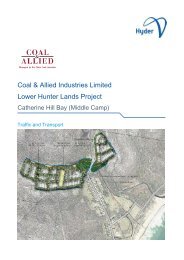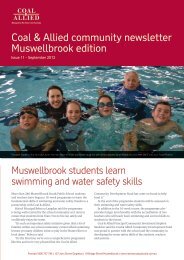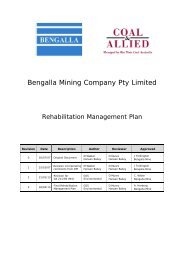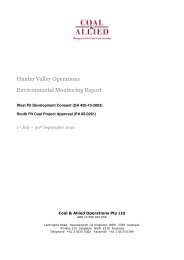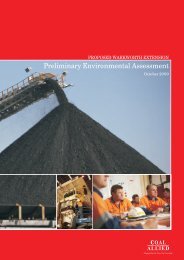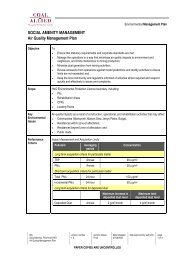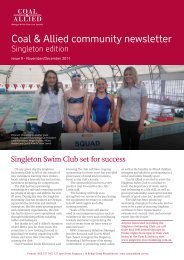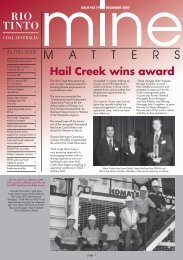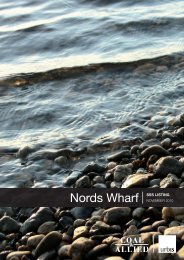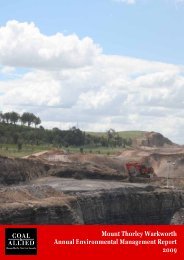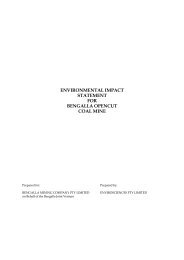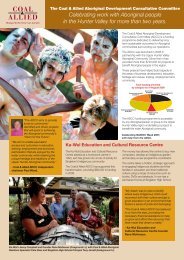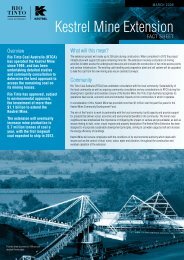HVO 2009 Annual Environmental Management Report - Final
HVO 2009 Annual Environmental Management Report - Final
HVO 2009 Annual Environmental Management Report - Final
You also want an ePaper? Increase the reach of your titles
YUMPU automatically turns print PDFs into web optimized ePapers that Google loves.
Coal & Allied – Hunter Valley Operations<br />
3.23.5 Contribution of Mining Emissions to NO 2 and PM 10 in the Upper Hunter<br />
Coal & Allied continues to play a leading role in supporting research into mining impacts on air quality in the<br />
Hunter Valley. Coal & Allied works closely with the Australian Coal Association to actively support and<br />
manage research projects funded through ACARP and over the last 10 years has supported nine major<br />
research projects into dust and blasting fume emissions.<br />
The most recent work has concentrated on:<br />
<br />
<br />
<br />
Understanding the composition of dust emitted from open cut mines and the resultant fine dust impacts in<br />
local communities;<br />
Developing tools to better predict dusty conditions and proactively manage dust; and<br />
Characterising and quantifying the gaseous emissions from blasting activity to determine emissions of<br />
oxides of nitrogen and carbon monoxide.<br />
ACARP Project C18026: Respirable Silica near Open Cut Mines in the Hunter Valley<br />
Recently the level of community concern relating to dust levels in the Hunter Valley has increased and this<br />
has prompted the Hunter Valley Mines to closely investigate the quantity and chemical make up of the dust<br />
emitted. An element of particular concern is silica which can cause the lung disease silicosis.<br />
This 18 month project started in July <strong>2009</strong> and aims to carry out a risk assessment on the levels of silica in<br />
the air surrounding open-cut coal mines. The major project objectives are to:<br />
<br />
<br />
<br />
<br />
Sample respirable particulates (PM10, PM2.5) in the Hunter Valley airshed in the vicinity of operating<br />
open-cut coal mines;<br />
Measure levels of respirable silicon using ion beam analytical techniques;<br />
Determine the mineral species which contain silicon (silica, silicates) and the morphology (crystallinity) of<br />
the silica using Scanning Electron Microscopy (SEM), QEMSCAN and Transmission Electron Microscopy<br />
(TEM); and<br />
Carry out an initial risk characterisation based on the levels of measured silica.<br />
ACARP Project C19034: Meteorological Models to Improve <strong>Management</strong> of Dust from Open<br />
Cut Mines<br />
This new project aims to use soil and meteorological information to calculate an easy-to-interpret dust index<br />
that will provide a quantitative estimate of the risk of dust impacts in the next 24 hours. If successful, this will<br />
allow mine operators to proactively implement dust reduction measures in advance of adverse weather<br />
conditions.<br />
This 12 month project will utilise the highly accurate weather forecasts generated by the Hunter Valley<br />
Meteorological Sounding Group Joint Venture together with the predicted state of the topsoil to forecast dust<br />
conditions in the next 24 hours.<br />
Emissions from Blasting in Open-Cut Coal Mining<br />
An ACARP project run by CSIRO (Commonwealth Scientific and Industrial Research Organisation) aims to<br />
use continuous spectroscopic monitoring for a period of at least two years to determine the concentration of<br />
Nitrogen Dioxide at the boundary of a large open-cut coal mine. The results of this project could then be used<br />
to quantitatively determine the contribution of blasting to ambient Nitrogen Dioxide concentrations in<br />
surrounding districts. In addition, hydrocarbon emissions from blasts will be sampled and analysed to<br />
determine the range of compounds released.<br />
The project commenced in <strong>2009</strong> with preliminary work consisting of site selection and off site development of<br />
the uv-DOAS (ultra violet – Differential Optical Absorption Spectroscopy) instrument for long term remote<br />
monitoring. The South Pit at Warkworth was selected as a suitable monitoring location where it borders Putty<br />
Road. Site setup and monitoring will commence in 2010. Coal & Allied are the Industry Monitor for this<br />
project.<br />
AEMR <strong>2009</strong> 155



